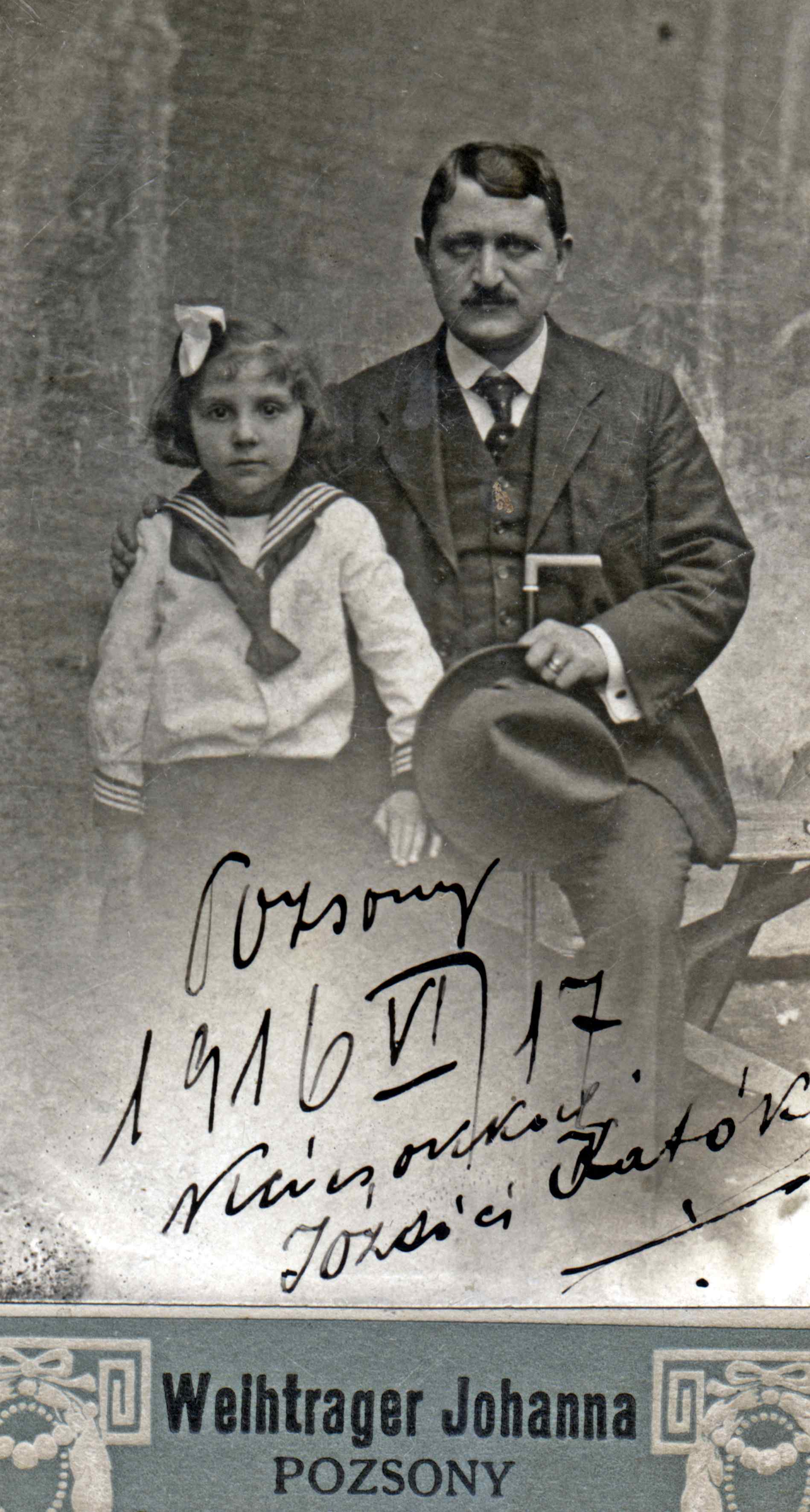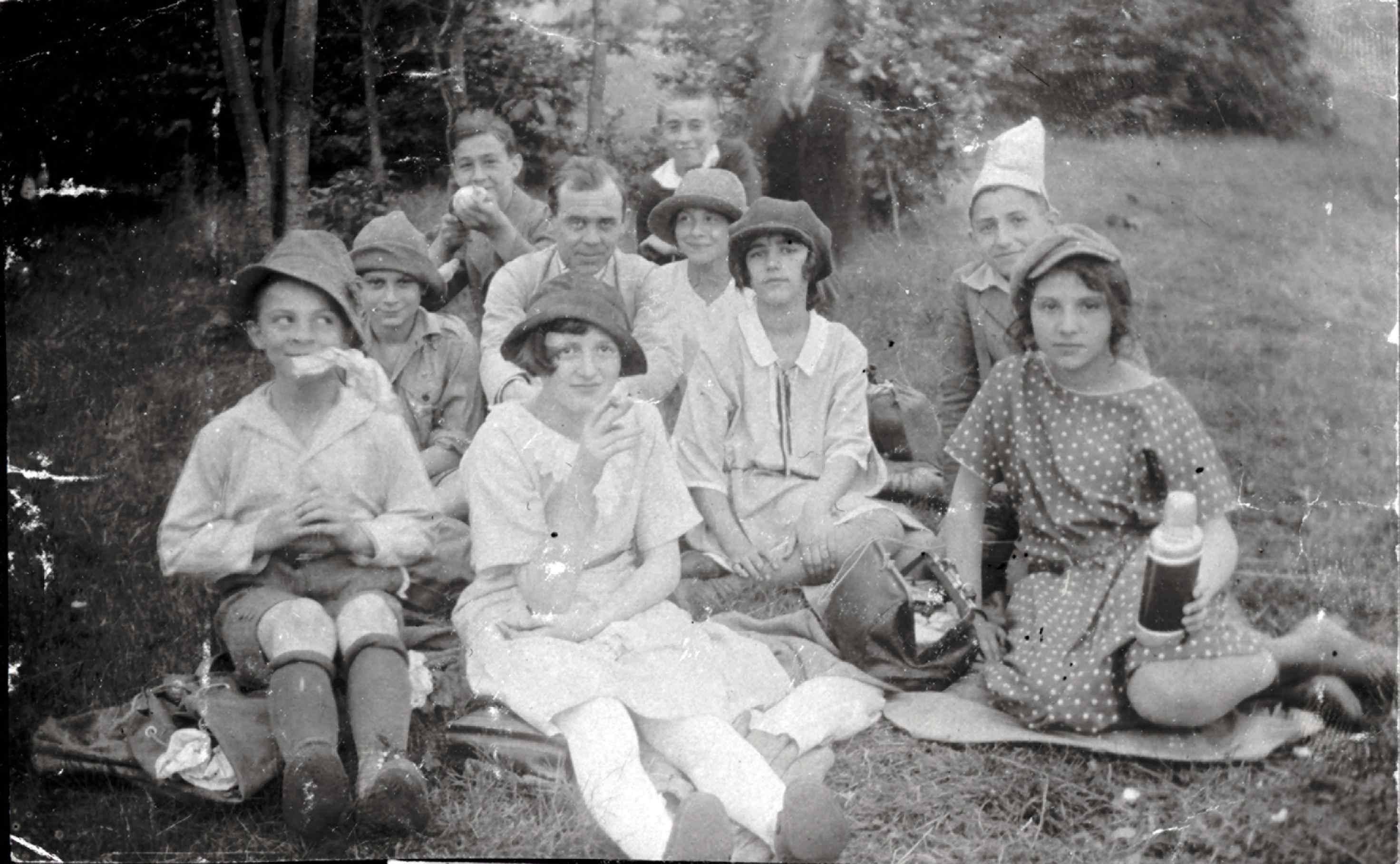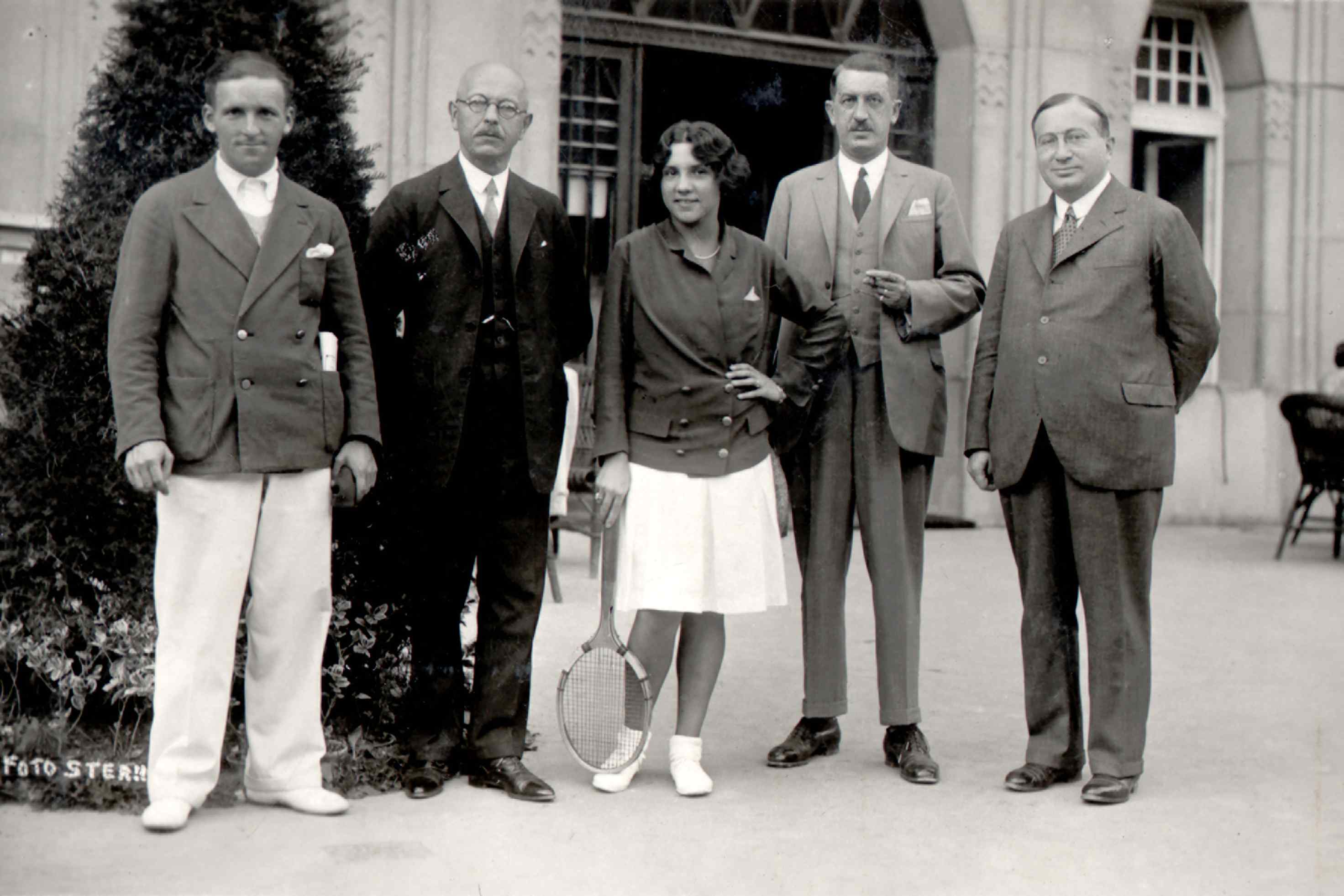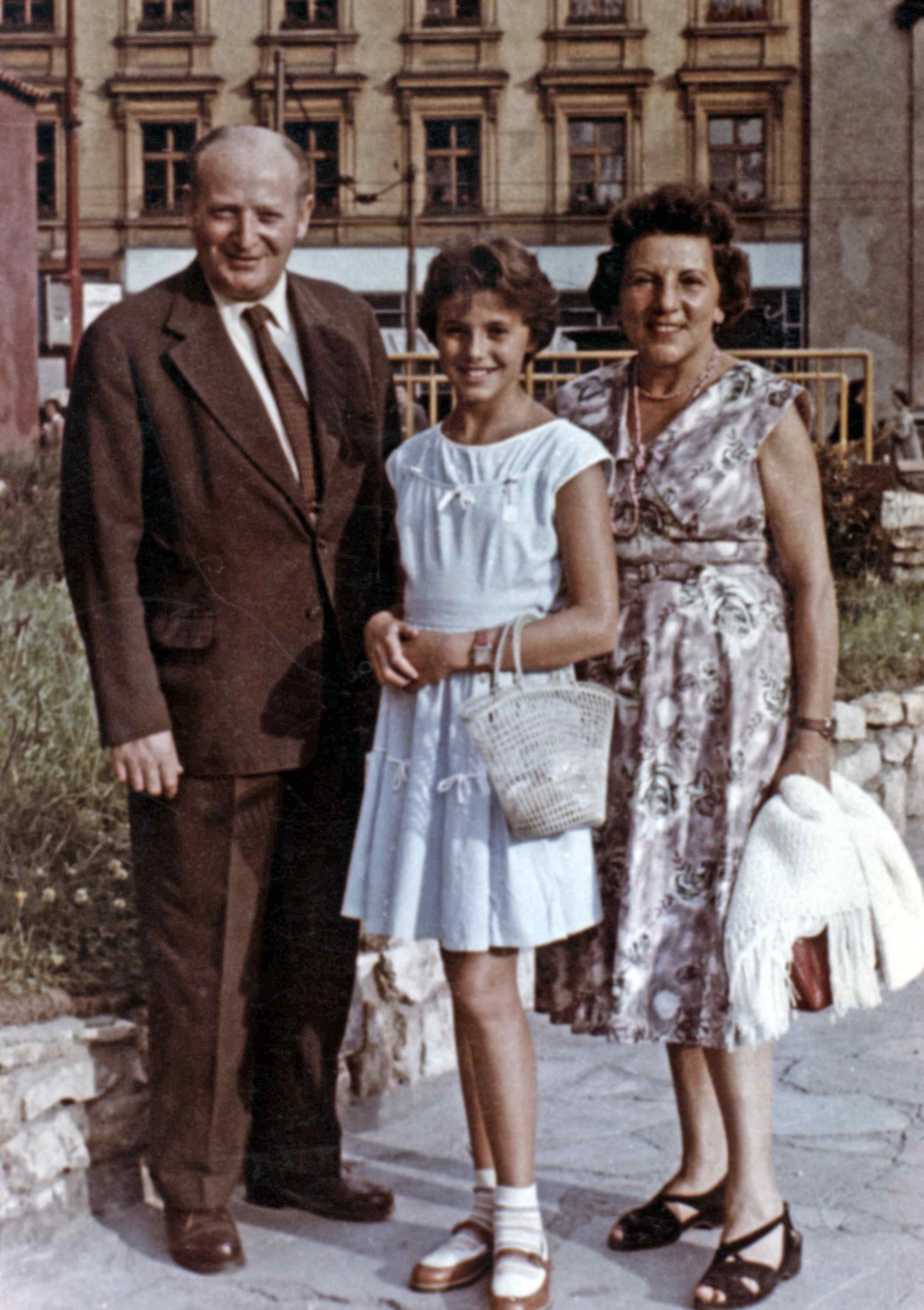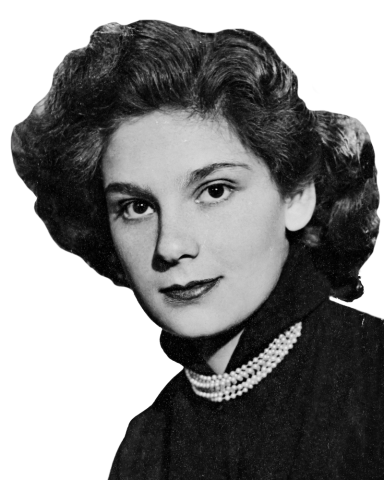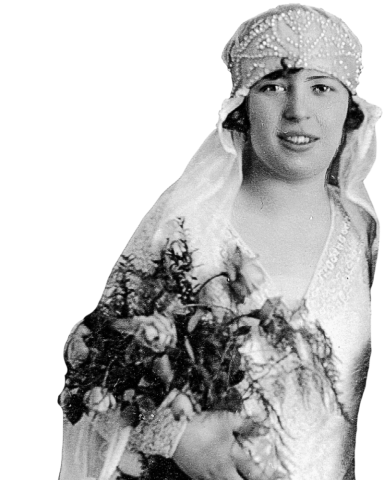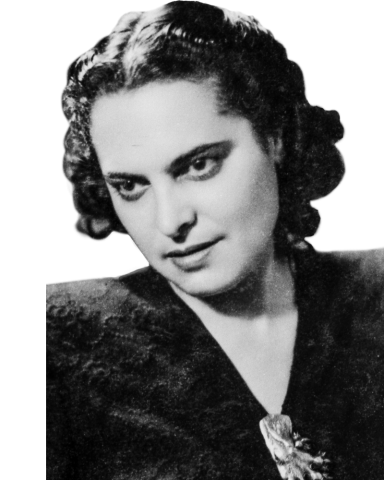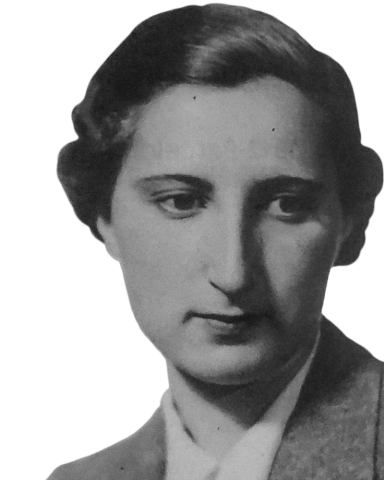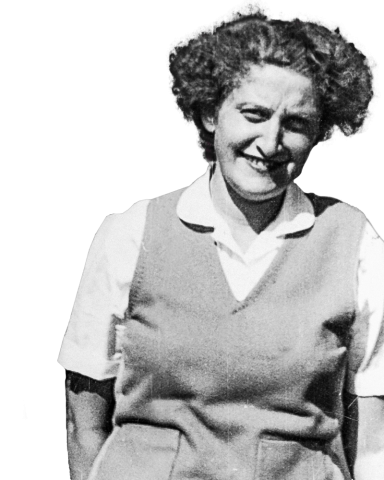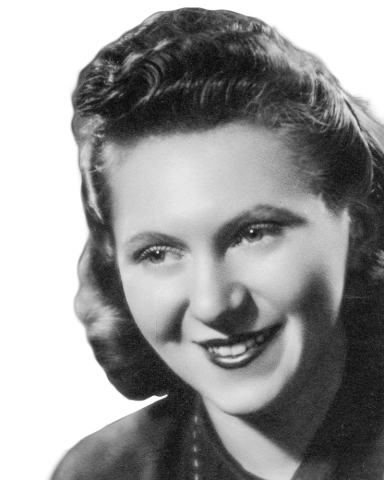
Katarína Löfflerová
Katarína Löfflerová was a Jewish Holocaust survivor, surviving several concentration camps. Living her whole life in Bratislava, speaking several languages, she was the true Central European in heart.
Interviewer
Martin Korcok
Year of interview
2004
Interview location
Bratislava, Slovakia
Watch the film
Click here to watch Centropa's documentary about Katarína Löfflerová.
(Available with Czech, Hungarian or Slovak audio and English or German subtitles.)
Growing up and family
Katarína Löfflerová with her father
My maiden name was Katalin Vidor. I was born on Grosslingova Street in Bratislava in 1910. My younger sister Alžbeta Dukeszová, née Vidor, was born in 1917 in Bratislava. I was seven years old when she came into the world. I was jealous of my little sister, since everybody paid attention to her, but we ended up having a really good relationship.
None of the families of my grandparents were Orthodox. In 1871, if I recall correctly, the Neolog community [fn]Neolog Judaism was a reformed branch of Judaism in Hungary, formed independently after the 1868 Congress in Pest. The branch was influenced by the religious reforms and assimilation tendencies of Hungarian Jews.
[/fn]was founded in Hungary. So everyone on my paternal side, just like on the maternal side of my family, were members of the Neolog community.
In our household we always had a maid; it was natural. They usually came from the Žitný ostrov region (in Hungarian Csallóköz), only knew Hungarian and were glad to get a chance to come to the city. Our maids were like members of the family. They all lived with us, but they ate separately. The last girl who was with us was from the Záhorie region of Slovakia. Maria Sevcikova was her married name. She was an intelligent creature; she hid my mother three times in 1942. She cooked, cleaned and aside from that, she was in charge of taking care of me. I was never in a kindergarten, not me, not my sister, and none of the children of my friends. The maid, who was always at home, looked after me. Then she moved away. So we didn’t have a maid, just a cleaning lady. They had maids in a lot of families, like we did.
A Fräulein [governess] came to our house, so we could learn German. Both me and my cousin, the son of my mother´s sister who lived with us, had a Fräulein who quit a short time later because she couldn’t take us.
Going to school and work
Katarína Löfflerová on a school trip
I went to a Neolog grammar school on what is Zochova Street today. In secondary school, we weren’t allowed to go to school together - the boys and the girls had to go to different schools. I finished my first year of grammar school during World War I. After that, I went to the Lutheran lyceum, which was, at that time, the best secondary school. It was the so-called ‘conservative’ high school, because aside from Latin, we learned Greek, too. I never felt antisemitism when I went to the Lutheran lyceum after grammar school.
I also did sports, and in the sports clubs I didn’t know who was Jewish and who wasn’t, what the religion of the people was, nor even their nationality.
Here in Bratislava, we spoke three languages, or rather two, we only learned
Katarína Löfflerová at the tennis tournament in Trenčianske Teplice
Slovak a lot later. But there [in the sports clubs] people weren’t even Slovaks, a lot of first-rate athletes came from the Czech Republic. The Czechs were better skiers, so we were average [when competing] compared to them, but in a sports club it never happened that somebody would judge you for your religion.
Despite not liking them, I attended piano lessons. But I went, I practised, because it was important to know how to play the piano. The girls from so-called “good families” attended everything.
When I was 15 or 16, my parents said that now I have to learn a foreign language – aside from Slovak, German and Hungarian, which didn’t count as foreign languages. I learned English, which was very useful for my future work.
My parents were athletic. We often went swimming together. They let us do anything on Saturday and holidays. We never kept the Sabbath. My grandparents didn’t either. Just the New Year and Yom Kippur, the Day of Atonement.
After school, at first I was working at an insurance company, but only for a short time. Where I worked for the longest time was in the Klinger factory, the foreign department. I was there for years, all the way up until they threw me out after the Germans took over the factory and kicked out some of us for being Jewish. I was thrown out near the end because I was employed in the export department, and the Germans needed my English knowledge.
During the war
In 1933, Hitler came to power in Germany. Up to this point, we had no idea what antisemitism was about, not many even knew what it was. Between the two wars, you didn’t feel any antisemitism.
The emigrations started after 1933. The optimists, like myself and my family, stayed. Because we said that in a country where the head of state [Josef Tiso] was a Catholic priest, the kind of things happening in the neighbouring countries couldn’t happen here.
When they introduced the yellow star system, some of us at first had to wear the six centimetre star, sewn on the part of your clothes visible under your overcoat. Later there was an order that workers didn’t have to wear it if they were working.
After the formation of the Slovak State [fn]On 14th March, 1939, the Slovak Diet declared the independence of Slovakia from Czechoslovakia and the so-called Slovak State was created. The country was tightly controlled by Nazi Germany.
[/fn], every week more and more anti-Jewish decrees came out. First you had to submit all your valuables, jewellery, furs – not just the full fur coats, but coats with small fur collars as well. You also had to bring in your radios, so we couldn’t be informed about what was happening in the world. I just remembered that I had to bring my sports equipment in as well. Then, in 1940, we didn’t know yet, that soon enough the time would come when it wouldn’t be our valuables we submitted, but our lives.
I stayed at my job in the law office [fn]Löfflerová obtained this job between 1939 and 1940. Exact date is unknown.
[/fn]. Dr. Forster, the head of the office, successfully got me a work permit on every occasion. Very often, sometimes every day, I had to go to court. This was at the time when you only had to wear the small Jewish star. I was terrified, I always had case dockets in my arms. I generally squeezed the star in my left hand and if I saw the guard somewhere, I pinned it on quickly.
Saving men from the deportation to Auschwitz
The three men, my sister’s husband, my husband and my father, who was fifty-some years old, were taken to Ilava (detention camp) [fn]Ilava, northwestern Slovakia - was a work and detention camp designed for enemies of the ruling regime of the Slovak State. The detention camp in Ilava began operating at the end of March 1939 and continued until the end of the war. In contrast to political prisoners, detainees were held in the camp without due process—and in such cases all that was required was for the Ministry of the Interior to accuse an individual of "obstructing the building of the State." Both supporters and opponents of the ruling Hlinka's Slovak People's Party regime openly referred to it as a "concentration camp," thus acknowledging that it was modelled on the camps that the Nazis built for their political adversaries upon seizing power.
[/fn]. There they built an electricity dam. Later, they took them away to a collection camp in Žilina, where they were collecting people and deporting them from there to Auschwitz. I won’t tell all the details, but I successfully got permission and got into the Lager [German for ‘camp’] where they were keeping my father. As an older person, there was nothing he could do. I got a permission with his name on it, so he could get out of the camp. My father told me, meanwhile, where my husband and my brother-in-law were working. Luck was really with me – and my connections, of course – I arranged to have the two younger men sent on the train which went to Nováky labour camp, not the one going to Auschwitz. Well, that’s how I saved my immediate family in 1942, none of them were outside the country’s borders. We successfully got my brother-in-law and husband out of Nováky by getting them a work permit at a construction company.
Slovak National Uprising and consequences
On 20th August 1944, the Slovak National Uprising [fn]The Slovak National Uprising was a military uprising organised by the Slovak resistance movement during World War II in central Slovakia.
[/fn] broke out. The Germans invaded Slovakia and we lived in great anxiety about what would happen. In the meantime, we listened to the news, and we knew that the Germans were suffering very, very big losses.
The Hlinka’s guards [fn]The militia was maintained by the Slovak People's Party, which ruled the fascist Slovak State in the period from 1938 to 1945; it was named after Andrej Hlinka, who established the party.
[/fn]came for us and took us in on September 27, 1944. The guards took us to the Jewish Center; the building constituted the Jewish religious community’s property. They gathered about 1,500 people there, and we spent the entire night standing on the two stories of steps there. Quite early in the morning, before eight, we then had to march off to the train station. We stood at the station until noon. Then at noon, they put us in the boxcars. We ended up in Sereď [fn]Sereď labor camp was created in 1941 as a Jewish labor camp. The camp functioned until the beginning of the Slovak National Uprising, when it was dissolved. At the beginning of September 1944, its activities were renewed, and deportations began. Because the camp registers were destroyed, the most trustworthy information regarding the number of deportees has been provided by witnesses who worked with prisoner records. According to this information, from September 1944 until the end of March 1945, 11 transports containing 11,532 persons were dispatched from the Sered camp. Up until the end of November 1944 the transports were destined for the Auschwitz concentration camp; later, prisoners were transported to other camps in the Reich. The Sered camp was liquidated on March 31, 1945, when the last evacuation transport, destined for the Terezin ghetto, was dispatched. On this transport also departed the commander of the Sered camp, Alois Brunner.
[/fn], which was a collection camp, located about 60 km northeast from Bratislava. We were in Sereď for three days; that was something horrible. Due to the lack of space, they crammed us horribly together; it was monstrous. The boxcars came; again they packed us in for the first round, there could have been seventy of us, or maybe more. When we reached Čadca (a town located in North Slovakia, near the Polish border), we knew we were going towards Auschwitz.
I knew exactly what there was in Auschwitz. It was known, because two prisoners had successfully escaped in March 1944, and my husband at the time had met one of them. That’s why when I first saw Auschwitz, it wasn’t totally unfamiliar to me.
Auschwitz
We arrived in Birkenau and we had to get out, and they separated men and women. This was when I saw my father and my husband for the last time. An SS man who was standing not far from there, was from here, from Ružinov (hun. Főrév) [fn]Ružinov (or in Hungarian, Főrév) is a borough of Bratislava.
[/fn]. He looked at me, grabbed my arm and asked, ‘How old are you?’ I answered honestly, that I’m thirty-four. He said, ‘You’re still strong, you’re going to work.’ I stood with my arms around my mother, but somehow they shoved me over to the other side. That’s how I got on the side of life. Those who had gotten on the so-called side of life went a completely different way than those who were immediately gassed. I know the exact date, October 4, when they executed my parents.
Freiberg
I was in Auschwitz for a total of ten days. The liquidations started heavily. The gas chambers were operating day and night. Ten days later they put us back into the boxcars and for two days they hauled us around. After two days, we arrived in Germany, in Freiberg [fn]One of the sub-camps of the Flossenbürg concentration camp.
[/fn]. There was a porcelain factory which had been transformed into a military factory. We manufactured wings and certain parts for the rockets, with which they were bombing London. We worked either twelve hours a day or twelve hours a night under constant female supervision. I have to mention, that the female SS guards were a lot more cruel than the men. It was difficult physical labour, and we were continually tormented by hunger.
After seven months, they suddenly told us they were closing the factory. We stayed inside during the day, and those who worked upstairs saw that the SS were fleeing, and the previous workers, who had trained us, were fleeing as well and left us locked in the factory. We were scared of the SS and the Gestapo, not the bombs. When we thought, now we were really going to starve to death – they put us in boxcars again, but this time in freight cars without a roof. We were in those open wagons for sixteen days: they hauled us back and forth around Austria, Germany, and the former Czechoslovakia.
Mauthausen
We arrived in Mauthausen, and the really unlucky ones – and I was really unlucky – ended up down in the so-called Gypsy camp, where the SS women were already fleeing. There were only a few left there, and since they knew that the Jews were coming there, they gave the Gypsies authority and gave them a white armband.
There was a very nice creature among us, a lot younger than me. She said, ‘Whoever wants to come with me, I’m escaping.’ I immediately joined up. We were seven women, and we left. We didn’t get far, there was a forest there. We climbed and accidentally found the Czech political camp [fn]They were still in the Mauthausen camp, not a separate camp.
[/fn]. They hid us in the hay because they had beds here, filled with hay. On May 4, 1945, they said, ‘Ladies, freedom is here, the Americans are coming!’ At that, we climbed out with great difficulty, and got up. There was a balustrade there, we stood and watched; you didn’t want to believe your eyes.
Arrival back home
We went home by boat on the Danube and on the 22nd of May we arrived in Bratislava. The ship stopped exactly in front of that house, the one that they’d taken me away from. We headed toward the city, and our rabbi at that time, Dr. Frieder, was coming straight toward us, with two Jews. He saw, that we had just gotten off the ship, with no hair, bald, and he sent us to the Jewish kitchen to eat. When we arrived at the Jewish kitchen, after the shock, the people standing around us started with: ‘Were you with my mother, did you see my sister, you didn’t see my daughter, did you?’ One after the other, it was all questions.
Back then, I didn’t feel sad [from what had happened during the war] - and I wasn’t an isolated case. For me, only one important thing existed: to eat and eat and eat. I only heard about some others, who had aggressive incidents towards them, like people saying that more came back than had been taken away, but nothing like that ever happened to me.
There was an office, it was called the Repatriation office. Those who came home had to register, and everyone got 500 or 1000 crowns. As you went up the steps, there were names and addresses written everywhere. Everybody read all of them. When I signed in that I had returned, I put down my name there. This is how my uncle, when he arrived back, found me and I wound up living with him. Not too long after, I also found out that my husband at the time had also died in Auschwitz. They gassed him too.
Second marriage
Katarína Löfflerová with family
I met my second husband – Ladislav Löffler – when he was working for a forwarding agency and delivered a trunk from Pezinok to me. He was Jewish, but not religious. He stayed in Bratislava and lived through the war here, too, with false papers. I had no ambition to get married. I knew that I could support myself alone, since I spoke four languages. I could get a job, they’d already asked for me, but I didn’t really feel okay, yet.
Eventuallysaw that we got married in 1946. We worked a lot – I also worked with him, he already had his own forwarding agency. We worked night and day, Saturday and Sunday, a lot. After the war, emigration started again, many people came back after the war but decided to emigrate. But we did not want to leave. My daughter Anna was born in 1948.
Life during the Communism in Czechoslovakia
At first, I had a position at a construction company, but only for a short time. The longest time I worked , one place was at Household Business, in the head office. My husband was employed in a town called Nitrain. We went there to live, and we stayed for ten years.
In 1966, we returned to Bratislava. I got a new position in the propagation department, my task was to ensure the procurement of the annual stock. During this time I was in a car accident. That’s how I got on a physical disability pension at the end of the 1960s. I suffered some serious injuries. I was on a Revolutiondisability pension, and only later did I start working as a tourist guide at the travel agency, where I worked for twenty-six years.
I never came into conflict over my Jewish heritage. During the socialist times, I tried to immediately let them know that I was Jewish, because I’ve always liked to know what side we stand on, who’s the enemy and who’s the friend.
Velvet revolution and the years after….
In Czechoslovakia, 1989 was a time of big social changes, the Velvet Revolution [fn]The Velvet Revolution was a non-violent transition of power in what was then Czechoslovakia, occurring from 17 November to 28 November 1989, resulting in the end of the 41 years of Communist party rule in Czechoslovakia.
[/fn]. Every single day I went to demonstrate on SNP Square. Since the regime change, the world isn’t worse, but it is not really the case that I can give my opinion without risk. I give it anyway, but I’m always a little scared. My family is definitely living better than we did. You can live, it’s not so dangerous. You can always do something and make money, you just have to want to.
In 1991, I took my first western trip abroad, to Israel. Four years ago, I went for the second time. I constantly root for Israel, but I wouldn’t like to live there. Maybe I’m too Central European to live there. Maybe I’m too Central European for it, to live there.
